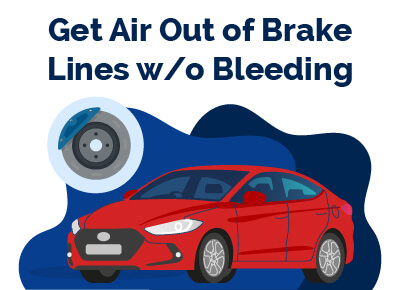How To Get Air Out of Brake Lines Without Bleeding
May 30, 2023


Chris is Head of Content for FindTheBestCarPrice and is based out of Philadelphia, PA. As a seasoned automotive industry analyst and car enthusiast, he ensures the highest level of quality across all our content and curates our picks for the best deals each month.
Chris studied information systems and marketing at Drexel University and writes about a wide range of topics ranging from car buying tips to troubleshooting common mechanical issues.
When he’s not thinking about cars, he likes to stay in with his dog and make an “attempt” to finish a crossword puzzle (he’s not quite at the Saturday/Sunday level…yet). As a former cheesemonger, Chris still has a “sharp” passion for all things cheese, and his fridge is always loaded with it!
Chris also has a passion for things that go fast, and drones are no exception. He spends some of his time writing for Dronesourced.
There's no denying that once in a while, you have to get the air out of your brake lines. But do you know that you can do this without bleeding the brakes? You can get air out of your brake lines without bleeding the brakes, but you must know how to carry out the process.
To get the air out of brake lines without bleeding, you can decide to get the air out through the hydraulic lines or loosen the bleeder valves to flush fluid and air, or attach a tube of hose to the bleeder and drain off the fluid to get off the air.
There are many ways to get this done. All that you need are professional aids on how to go about it. Read on to learn step-by-step guides on how to get the air out of brake lines without bleeding.
Table of Contents
Can You Get Air Out of Brake Lines Without Bleeding?
Yes, you can get the air out of brake lines without bleeding.
There are a lot of reasons why you might choose to get the air out of your brake lines without bleeding. There are chances that the bleeder isn't working properly again or don't just want to use them.
Whatever the case may be, you must know that it is possible to remove air from your brake lines without necessarily bleeding them.
How To Get Air Out of Brake Lines Without Bleeding
There are different ways to get the air out of your brake lines without bleeding them. You can either do this through the master cylinder or by simply using a hose on the bleeder or through the hydraulic lines.
Here are the detailed steps to get the air out of brake lines without bleeding.
1. Gather the required tools.
There are a few tools that you will need to properly get out air from your brake lines without bleeding them. Here are the tools that you will need to get the air out of your brake lines without bleeding them.
- Hose.
- Plastic container.
- Car jack.
- Funnel.
- Assistance from a friend or colleague.
- Dry cloth or rag.
- Gloves.
You can proceed to the next step if you've got all the tools mentioned here.
2. Jack up the car to access the brake lines.
Get a car Jack to jack up the car to access the brake lines. Make sure to use jack stands to secure the car in place.
Decide if you wish to get the air out of your brake lines through the master cylinder, bleeder screw, or hydraulic lines. The efficiency, efficacy, and accuracy level are not the same for all of these steps, so you'll have to decide which one works for you.
Let's start with how to get the air out from the bleeder screw.
3. Locate and unscrew the bleeder screw and attach the hose.
The bleeder screw is located at the top of the brake caliper. It's designed as a long, cylindrical piece with a rubber cap on it.
You can use a wrench to unscrew the bleeder screw one at a time. You should wear hand gloves to protect your hands from the corrosiveness of the brake fluid.
If the bleeder screw is stuck or won't lose due to rust or corrosion, then you use a wide brush to clean it a bit with penetrating oils or give the screw a gentle tap with a small hammer. Ensure that the taps are gentle to avoid cracking or destroying the caliper and screws.
After loosening the bleeder screw, attach one end of the tube to the bleeder screw and another end to an empty plastic container. The tube should be long enough to reach a container on the ground. You'll need the container to catch the breaker fluids as they come out.
4. Pump the brakes with a friend’s help.
After firmly securing one end of the hose on the bleeder screw and the other end into the container, get a friend to pump the brakes while you watch the hose.
Make sure the tube is fully submerged in brake fluid, and there are no leakages to prevent air from entering the brake lines. For extra protection, you can wrap the bleeder screw with a cloth material to ensure that it doesn't pull out from the bleeder.
5. Close off the bleeder screws and remove the hose.
You can have your friend continue applying the brakes until all the fluids are completely drained. However, you can choose to stop applying pressure when you don't see any more air bubbles coming out of the tube. Close off the bleeder screw and remove the hose.
Ensure that you clean the bleeder screws to prevent dirt from getting into the system. A little lubrication on the metal parts will prevent tightening problems.
6. Refill with new brake fluid.
Now that you've drained all the air from the brake lines, together with the brake fluid, you can proceed to refill the brake fluid reservoir with new brake fluid.
You can do this by adding brake fluid from the master cylinder reservoir.
How To Get Air Out of Brake Lines Without Bleeding From the Master Cylinder
Using a hose on the bleeder screw isn't the only way to get the air out of the brake lines. You can also get out air from the master cylinder reservoir.
All you have to do is to open your car's hood, locate the master cylinder reservoir and open the cap. Clean the cap and put it back, but this time around, you'll place the arrow in a position that points toward the wheel that you need to pump first. Repeat this process for all four wheels of your car.
In this position, get a friend to continuously march on the brake pedals at least 20 times until it becomes firm and you can't feel air coming from them again.
Some cars have dual-master cylinders, so you must ensure that you repeat the process for all the cylinders. Refill with new brake fluid when you are done.
You can start your car's engine and step on the brake pedal another 20 times to remove any excess air that wasn't flushed.
Conclusion
We believe you've learned how to get the air out of your brake lines without bleeding. You'll need to learn all the processes and decide which one gets the job done for you. There's no harm in seeking the aid of a professional if you feel you can't handle the task.
Best Car Deals by Category
Frequently Asked Questions
Is Bleeding The Brakes Necessary?
Bleeding the brakes is a necessary part of your car's maintenance. They are a good way of removing brake fluids from the brake system, but also a good means of removing trapped air in the brake system. This increases the efficiency of your brakes.
What Are The Risks Of Not Getting Air Out Of Your Brake Lines?
The risks involved in not getting air out of your brake lines are brake inefficiency and poor performance, reduced hydraulic pressure, increased chance of accidents, or inability to control your car.
Will air work itself out of brake lines?
No. Air will not work itself out of your brake lines. There's no way that your brake lines will get better if you don't work on them. The brake pressure will remain poor, producing bad braking response. This will continue until you decide to flush the fluid and let out the air bubbles.
How do you know if you have air in your brake lines?
There are a lot of ways that you can know that you have air in your brake lines. Here are some of the easy signs to tell that air is in your brake lines: the brake pedal feels spongy or soft when you press it, the brake pedal goes all the way to the floor when you press it, or your brakes won't function properly.
How long does it take to get the air out of brake lines without bleeding?
The time it takes to get the air out of brake lines without bleeding depends on the method you use. Some methods are faster than others, but on an average scale, it should take 30 minutes to one hour to get the air out of your brake lines without bleeding.
How often should you get the air out of your brake lines?
It's usually advisable that you should get the air out of your brake lines every two to three years. However, we believe that's a long time to wait, and the chances of having air in your brake aren't standard on all vehicles.
It's advisable that you get the air out of your brake lines whenever you notice any of the signs that air is in your brake lines.
Posted in Car Buying Tips, Car Troubleshooting |




